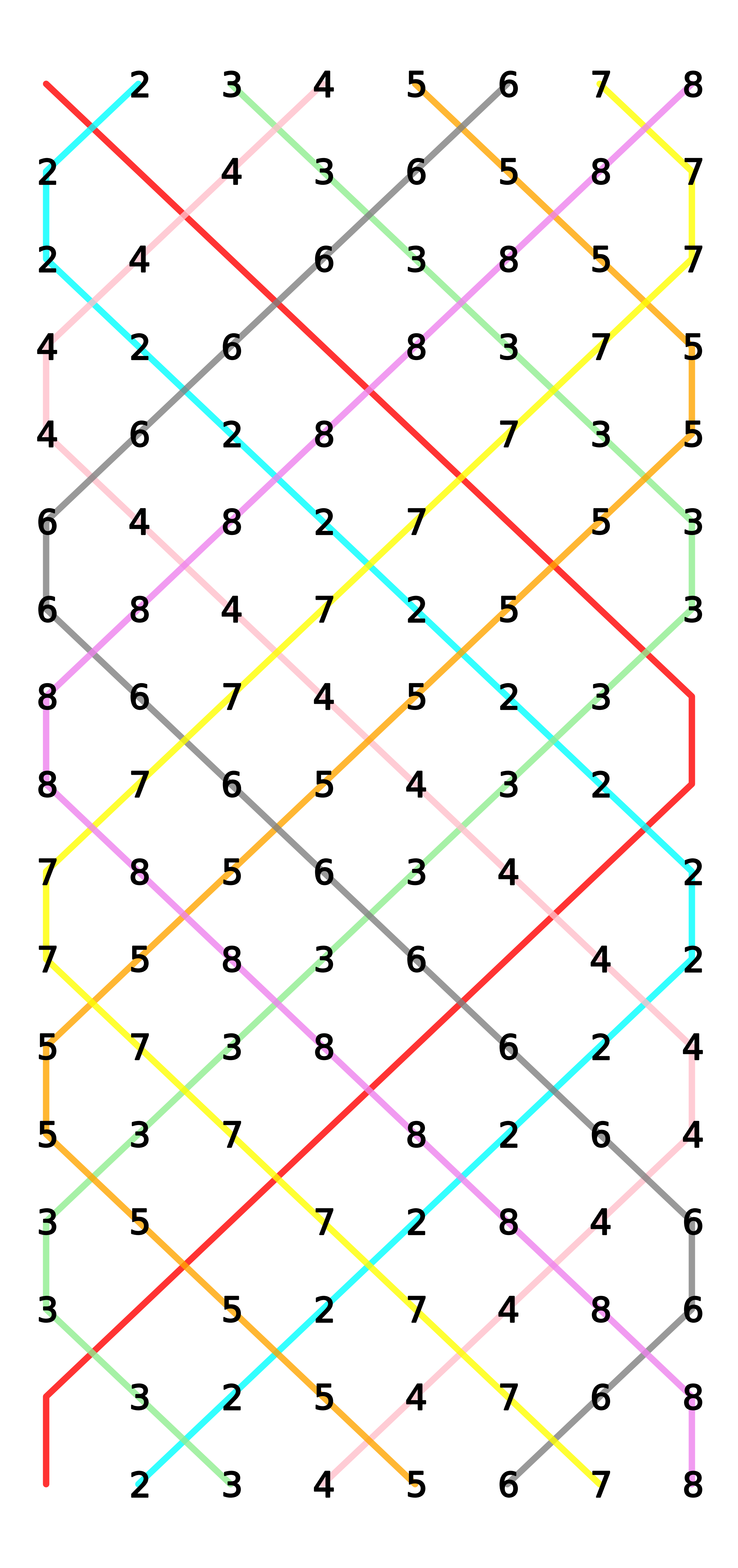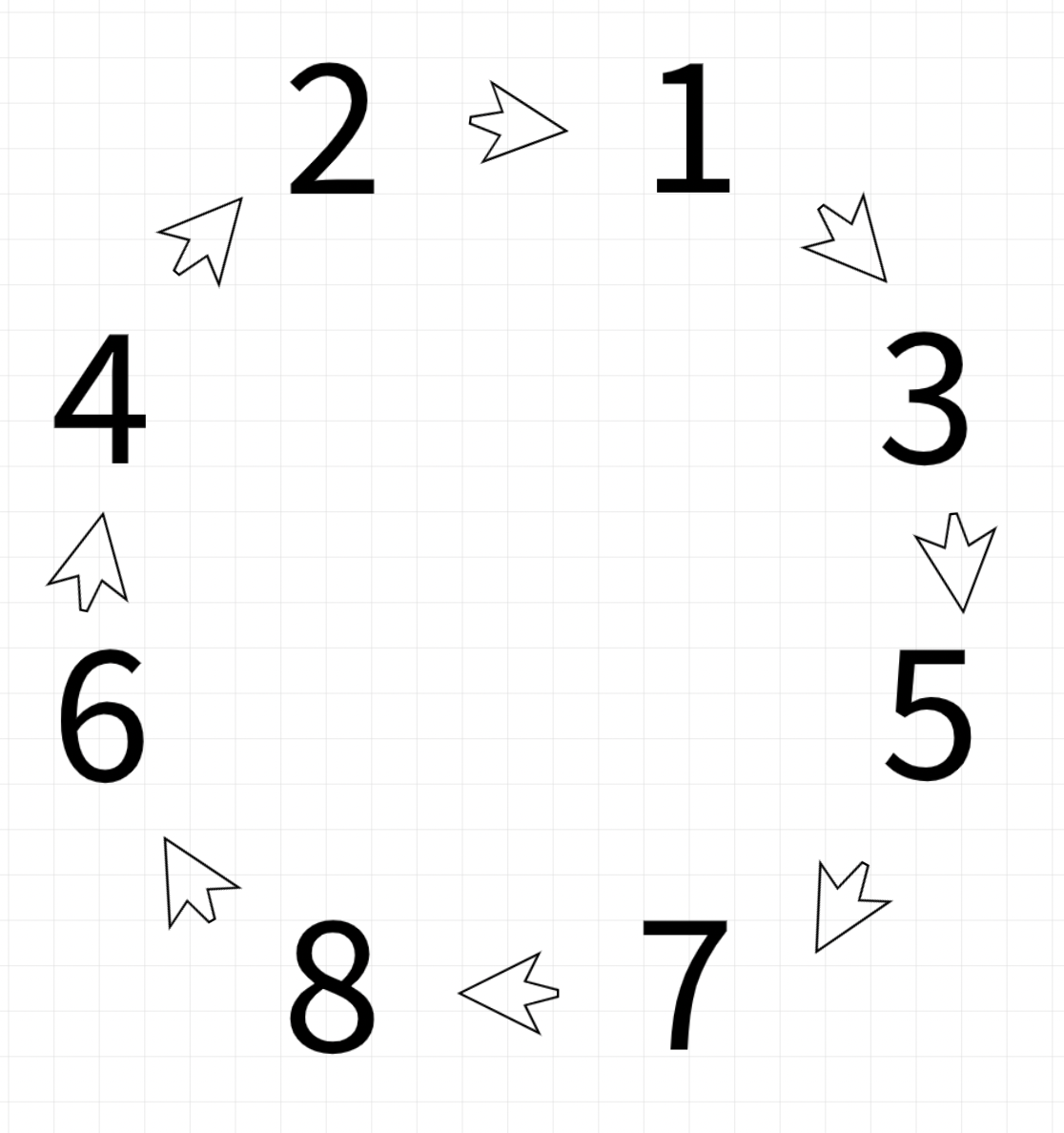Coursing Orders #
Coursing orders are a fundamental tool of the conductor, and many if not most conductors use them for checking the ringing. But what is a coursing order? This section is here to answer that question. For this section and the next, we’ll focus on coursing orders in the context of Plain Bob.
Back to Basics: Plain Hunt #
Let’s take a good look at plain hunting.

Here, the red line is the treble, and all the other bells are shown by both their number (like “4”) and by a particular color. I’ve always loved looking at the grid for plain hunt, because it has such pleasing symmetry; but it contains other interesting facts as well.
Look at the order in which the bells come to lead. After rounds, the 2 leads, then the 4, the 6, the 8. Then the odd bells: 7, 5, 3. Finally, it’s time for the treble’s lead again.
Look at the order in which the treble passes all the bells. First the treble rings over the 2, and then the 4, the 6, and then 8. Then the odd bells: 7, 5, 3. Finally, it’s the half lead and the treble turns around at the back. Who should the treble meet but the 2 again? Then it rings over the 4, 6, 8, 7, 5, 3 again before it gets to lead.
The orders are the same, and this ordering of the bells all passing by each other, rotating within the method, is known as a coursing order. This order is perturbed by calls but remains steady within a method otherwise. Because this order is preserved when there are no calls (and it changes when there are calls), it will be useful for the conductor, who is concerned with how the order of the bells changes over the course of a composition.
When writing coursing orders down, we often write them in a condensed format, like this: 2468753. That long string of numbers corresponds to the order in which the bells lead in plain hunt, which (for Plain Hunt) is the same as the order in which the treble passes the bells. Other methods may have different ways of spotting the coursing orders, and different coursing orders entirely.
However, you can write down the coursing order relative to any bell. Try it out a few times here:
When the 4 is hunting up, what bells does it pass, and in what order? Try writing it out yourself before looking at the possible answers below.
When the 3 is hunting down, what bells does it pass, and in what order? Try writing it out yourself before looking at the possible answers below.
When the 8 is hunting down, what bells does it pass, and in what order? Try writing it out yourself before looking at the possible answers below.
Conventions #
Here are a few things you might have noticed:
- Although I showed plain hunt on 8 bells, there are only 7 bells in each coursing order above. That is because it is conventional to miss out the bell from which you are observing the coursing order. So if you are watching from the 2, you will generally not place the 2 in the coursing order.
- You can also write out the entire coursing order, not relative to any bell at all. For plain hunt it might look like this: 13578642. Or it might look like this: 86421357. The order is a cycle, which means you can start anywhere and write out the rest of the bells and the order will be the same. Unfortunately, because writing moves along the page in a line, it is terribly limited when it comes to discussing cyclic things — especially on a computer. It takes a bit more work, but I think a very sensible way to write out coursing orders is like this:

- In methods where the treble is doing different work to the other bells (so for example, in Plain Bob where the treble hunts while all the other bells do other things), it is conventionally left out of the coursing order as well.
- And finally, although it’s by no means necessary, it is once again conventional to write out coursing orders relative to the heaviest working bell.

That’s a lot of conventions! Not all of them are kept to all of the time, and different people have different preferences. But I just want to inform you about what you are most likely to see.
Coursing orders in Plain Bob #
So let’s take a look at Plain Bob Minor and think about how we might write out the coursing orders, given the above conventions.
By convention, we pick the heaviest working bell and write out the coursing order relative to it. Can you spot it?
What's the coursing order from the heaviest bell, for the first lead? Include the treble.
Great. You might note that I added the caveat “for the first lead” in the question. This is related to the convention to leave out the treble. Check out the coursing order relative to the 6 in the first lead, and then look at the second lead. Notice anything different?
That’s right, the 6 crosses the treble at a different point in the second lead. That’s because the treble has swapped spots with the 3 at the lead end! The treble will continue to do a do-si-do with various bells at the lead end and will therefore move all through the coursing order. However, because it is doing different work to the rest of the bells, we often don’t consider it when we’re thinking about the coursing order. So, in Plain Bob Minor, a common way to write the coursing order would be:
5324
The treble may traipse through at will, but the 6 will always pass the working bells in that order in the plain course. Note that some people will prefer to write the 6 in all the time (giving 53246), but that is not the convention I will follow here in Calling It Round.1
Using coursing orders #
When you know what the coursing order ought to be, you can use it to set the ringing straight. For example, let’s say you are in charge and ringing the 6 during a plain course of Plain Bob Minor. You know that the coursing order should be 5324 because just before practice you were scrolling through Calling It Round on your phone. There’s a kerfuffle, and suddenly you’re passing the bells in this order: 5, 2, 3, 4. You can then shout out that the 3 and the 2 are over and ought to swap places.2
Similarly, if you know the coursing order throughout a composition, you can keep a constant check on the ringing by looking at the order in which you pass the bells (bearing in mind that this works well for Plain Bob and many other methods, but there are some methods where watching how you personally pass the bells will not tell you the whole story).
If you want to watch the coursing orders not from the heaviest working bell, you have a few different options. Different people will naturally prefer different solutions, but here are a few:
- Figure out what the coursing orders should be from the bell you are ringing. For example from the 2, the plain course has a coursing order of 4653. You can either re-derive or take the coursing order from the 6 (5324) and perform the following operations:
| Operation | Coursing order |
|---|---|
| [start] | 5324 |
| Add the current observation bell to the back of the line | 53246 |
| Move your bell to the front of the line (e.g. the 2) | 24653 |
| Remove your bell from the coursing order (e.g. the 2) | 4653 |
This set of operations will allow you to “translate” any coursing orders from one observation bell to another.
- Watch the heaviest bell ring and note the coursing order second-hand (in my experience, this is tricky!)
- Figure out how your bell can watch the coursing orders “as though” they were from the tenor. For example, say I’m ringing the 3 but I want to see the 5324 coursing order the way the tenor does. I wait until I see the 5, and then I start keeping track of who I see after the 5. I ring over the 5, then lie behind, then see the treble, the 2, the 4, and the 6. So, except for myself who obviously I can’t pass, I see the bells in the order 5(3)246; exactly as desired.
Some of these methods may seem needlessly complex to you, or may seem so much more simple than the others that they are obviously what one should use. But people use a huge variety of these methods and everyone has a different preference!
Practice #
By now you may be feeling pretty familiar with the concepts above (and if you are not — that’s ok too! I’ve listed a bunch of resources below that you can use to learn more.) Let’s move beyond plain courses of Plain Bob, and practice reading the coursing orders of Plain Bob in other contexts. I will provide a lead of Plain Bob, and you will provide the coursing order from the 6, omitting the treble.
Unlike before, instead of multiple choice, these will be short answer. If you get stuck, try working through the previous examples on paper and then try this one again.
More resources #
Many people more knowledgeable than I am have shared their wisdom on coursing orders, and I recommend reading what they have to say. A few select resources are as follows (and as ever, I’m happy to add more as they come to my attention):
Online #
Thomas Alspaugh’s notes on Plain Hunt
In Print #
- John Longridge’s “Conducting & Coursing Order”
- The Learning Curve “Conducting & Coursing order” (The Ringing World)
- Steve Coleman’s “The Bob Caller’s Companion”
Notes #
Writing 53246 instead of 5324 gives more information and is less ambiguous. However, you will see 5324 at least as commonly as 53246, so I feel working with these abbreviated coursing orders is a useful skill to build. When you start calling and conducting on higher stages, too, the coursing orders will also commonly be abbreviated, and using this convention for minor gives good practice. ↩︎
For some bands, it’s sufficient to shout that the bells are crossed and they’ll immediately right themselves. However, there are some things you can do as a conductor to make that swapping easier; see Giving Guidance for more information. ↩︎